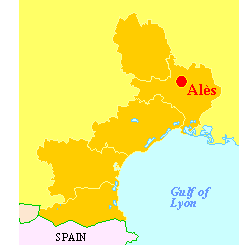

![]() A
Celtic village, later a Medieval market town, then a centre
of the European silk industry and of coal mining, Alès
is now a commercial and light industrial city. The River
Gard (or Gardon) flows through it.
A
Celtic village, later a Medieval market town, then a centre
of the European silk industry and of coal mining, Alès
is now a commercial and light industrial city. The River
Gard (or Gardon) flows through it.
Louis Pasteur came here and discovered a remedy to a disease
that was attacking mulberry bushes, and thus crippling the
silk making industry since silk worms need healthy mulberry
bushes. There is a fine allegorical statue of Pasteur, holding
aloft a healthy mulberry branch and helping to a feet a
young girl representing the town. The statue can be found
in the Jardins du Bosquet near to Fort Vauban, one of the
many fortresses designed by the great Maréchal
de Vauban 
Nearby is the Cathedral. Note the eighteenth nave tacked onto a Romanesque west front.
To the north-east of Alès you will find the twelfth century Château de Rousson and, if you are interested in birds from around the world, the Parc Ornothologique des Isles.

![]() An important pilgrim route, the Via Tolosana (marked in blue on the right) led through Arles, St-Gilles, Saint-Guilhem-le-Désert and Toulouse and crossed the Pyrenees to join other routes at Puenta-la-Reina, thence to Santiago along the Via Compostelana to Santiago de Compostela.
An important pilgrim route, the Via Tolosana (marked in blue on the right) led through Arles, St-Gilles, Saint-Guilhem-le-Désert and Toulouse and crossed the Pyrenees to join other routes at Puenta-la-Reina, thence to Santiago along the Via Compostelana to Santiago de Compostela.
Another route, the Regordane (marked in green), led from Le Puy-en-Velay to St-Gilles, by way of the Cévennes, Alès and Nîmes. Some pilgrims came only as far as St-Gilles, the fourth most important pilgimage destination in Europe. Others went on to Santiago de Compostela along the Via Tolosana possibly taking a detour to Saintes-Maries-de-la-Mer (While Compostela claimed the relics of St-James, Saintes-Maries-de-la-Mer claimed the relics of his mother, Mary) |
|
Car Hire






